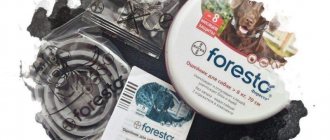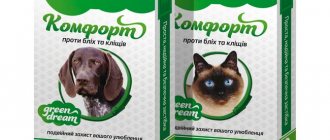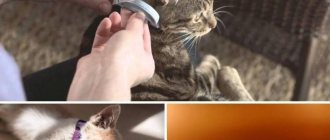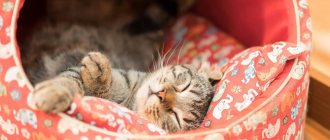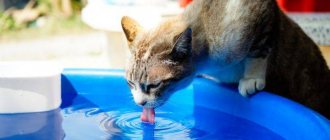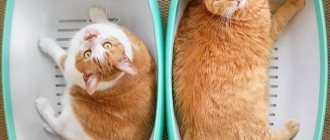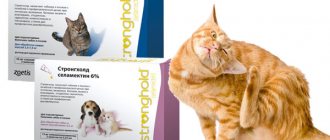Every experienced cat owner knows how much inconvenience fleas and other ectoparasites (ticks, lice, lice eaters) cause cats. And the problem is not even that their bites prevent pets from sleeping and resting peacefully, everything is much worse. Fleas and other blood-sucking creatures are carriers of dozens of infectious diseases. The paws of these bloodsuckers are an ideal means for “delivering” helminth eggs. In addition, constant bites often cause the development of dermatological pathologies (dermatitis and eczema). To prevent the occurrence of all these diseases in your pet, it must be protected. In the article below, you can choose the best anti-tick collar for cats, having first studied all the products in our rating. Happy choosing!
Composition and operating principle of a flea collar for cats
The cat collar is impregnated with a special toxic substance (insecticide or repellent). Similar substances are often found in anti-flea shampoos, sprays and other flea and tick treatments. When the device is put on the cat’s neck, it begins to gradually release this impregnation. This leads to the destruction of existing parasites, and also protects the pet’s skin from insects.
The collar is effective only at the initial stage of infection (i.e., when ectoparasites have not yet harmed the cat’s health) or for prevention. For moderate to severe infestations, the use of shampoos or drops is recommended.
A safety collar for cats may contain the following components:
- Essential oil (such as peppermint or lavender). The scent of these oils repels parasites, preventing infection. However, for already infected cats this component is useless.
- Diazinon is an effective insecticide, but can cause a severe allergic reaction in a pet.
- "Propoxur" is a moderately toxic substance that helps repel insects.
- "Sevin." It is also a moderately toxic component and has an extended area of action.
- "Phenothrin." Often used by people as a drug for lice (lice). No less effective for pussycats.
- "Metropen" is a rather aggressive component that is contraindicated for kittens.
- "Imidacloprid" is an insecticide that has a nerve paralytic effect.
- "Fipronil" is a common insecticide, effective against most known ectoparasites.
Another component that is added to anti-parasitic collars for cats is permethrin. But due to its high toxicity, veterinarians rarely recommend its use.
Why are fleas and other external parasites dangerous?
The flea lays eggs and reproduces in the cat's fur.
Cat fleas feed on the blood of the animal, moving along the body by jumping. Insects lay eggs from which larvae emerge; they soon pupate and turn into full-fledged adults. Flea bites cause pain and discomfort to the cat, and the saliva of the parasite that penetrates the wound causes itching and can cause anxiety and severe allergic reactions. An insect can be a carrier of dangerous diseases:
- hepatitis A;
- salmonellosis;
- encephalitis;
- feline distemper;
- typhus and others.
Fleas are extremely resistant to adverse environmental conditions. Having fallen off the pet's fur, they can live in an apartment for a long time - behind baseboards, in carpets and other furnishings, until they find a new victim. Parasites also carry helminth eggs, which they feed on. If a cat accidentally swallows a flea while combing its fur with its paw, tapeworms are likely to appear in the intestines. Blood-sucking insects are especially dangerous for kittens; they often cause low weight and anemia in animals.
Other types of blood-sucking insects are no less dangerous for cats. Thus, ticks can be carriers of borreliosis and anaplasmosis. Symptoms of the disease include fever, anemia, nosebleeds, kidney and liver damage. Mosquitoes often cause the development of dirofilariasis, which destroys vital organs.
Lice eaters feed not only on blood, but also on fur and particles of cat skin. They are much smaller than fleas and are difficult to see. At the same time, they can cause severe discomfort to the animal - cause itching, skin rashes, hair loss, and helminth infection.
Types of anti-parasitic collars
All anti-flea and tick collars are classified depending on the principle of their action:
- The first group is biocollars. They contain natural ingredients - plant oils that repel insects. For example, this is celandine, mint or lavender.
- The second group is insecticidal accessories. They are impregnated with a solution toxic to ectoparasites.
- The third group is radiating accessories. They transmit electromagnetic waves into the surrounding space that repel insects.
- The fourth group is ultrasonic devices. As the name suggests, they produce high-frequency sounds that can only be heard by insects.
Best GPS Collars for Cats
Collars with a GPS tracker are especially necessary for pets that walk independently. The devices allow you not only to see the current location of the cat, but also to study its habits, routes and behavioral characteristics. As a rule, collars are quite expensive, but provide the owner with ample opportunities: to issue a voice command remotely, set boundaries and receive a notification if the animal has crossed them, and much more. For correct operation, you need to install the application and purchase a SIM card for the collar.
Advantages and disadvantages
Like any pest control product, there are pros and cons to cat flea and tick collars.
The positive aspects include:
- Ease of use. Before putting on the accessory, your pet does not need to be thoroughly combed or bathed. You just need to put it on the cat’s neck, adjust the length and cut off the excess.
- Safety. Cases of poisoning, which are rare but have happened to cats, were 90% associated with the wrong choice of collar. Each model contains a certain dose of insecticide, designed for a particular weight of the cat. The most natural option would be bio flea collars for cats.
- Models have been developed for pregnant or lactating kisuls.
- Range. In any pet store or veterinary pharmacy you can find an option taking into account the characteristics of the kitty (weight, age, cat health).
- Highly effective as a prophylactic agent.
- No smell. Odorless flea collars for cats will only act on parasites, without interfering with the pet and its owner.
- Some anti-flea accessories indirectly protect the cat from infection with any helminths: many ectoparasite insects are carriers of worms. And when scratching or picking fleas, helminth eggs can enter the cat's body.
If we consider the disadvantages of anti-flea accessories, we can highlight the low effectiveness as a therapeutic device. They are ideal for preventing infection, but not for treating it. However, at the very initial stages, you can rid your cat of ectoparasites using a collar. Other disadvantages are:
- limited period of use. Once all the impregnation has evaporated from the collar, it becomes useless. Usually the impregnation lasts for at least one month. Some devices last even longer;
- low but present possibility of intoxication. But it increases only if the accessory is incorrectly selected and used.
The principle of operation of the protective agent
Flea collars for cats work on the principle used to create shampoos, drops and sprays against blood-sucking insects. The flexible polyvinyl chloride base contains microcapsules containing insecticides and repellents that kill adult insects that parasitize the animal’s body and repel strangers. Once you stretch the collar several times before use, a white coating appears on its surface. This insecticide is partially released from the capsules and the cat flea collar is activated.
Flea collars
The insecticides that are included in a cat flea collar are organophosphates (tetrachlorvinphos, diazinon), peritroids (cyphenothrin, deltamethrin, imidacloprid and flumethrin), amitraz, fipronil and carbamate pesticides. But they have the same principle of action - when an insect comes into contact with an insecticide, the transmission of a nerve impulse through the presynaptic cleft of neurons is blocked. The muscle fibers innervated by them contract spastically and cease to function. The paralyzed insect dies.
The insecticides used are substances of contact-intestinal action. The drugs have a low (3-4) toxicity class and, if safety rules are followed, cannot lead to serious poisoning of the cat.
Important!
It is imperative to follow safety rules. Even though insecticide poisoning is very rare, licking and chewing of the collar should be avoided. To do this, you need to correctly adjust the product to size, the excess strip is cut off. The anti-flea cat collar should be stored tightly packaged so that the active substances are not destroyed by exposure to air or light.
Some developers add S-methoprene to the capsules, which damages the juvenile hormone involved in the formation of chitin. As a result, the insect at the larval and egg stages develops abnormally and dies.
Repellents are natural substances made from essential oils and plant extracts that repel cat fleas with their scent. The active substances “stick” to the surface of the fur, spread in the lipid layer of the skin when the animal moves, penetrate the hair follicle and the cavity of the sebaceous glands, providing a prolonged insecticidal-acaricidal effect.
How to use the collar
All models are equipped with a special clasp and are adjustable in length. Do not place the device on the cat’s neck too tightly. It is important that it does not press or sting the cat, or make it difficult for him to breathe. A person's finger should fit between the kitty's neck and the product. The tip that remains must be cut off. Otherwise the cat will try to pull it or lick it.
Basic rules for using a flea collar for cats:
- You need to print the packaging immediately before putting the accessory on your cat. You need to check expiration dates before purchasing.
- While wearing an anti-flea product, the kitty should not be treated with other anti-parasitic agents. This will lead to an overdose, since each of the products contains toxic insecticides. In this case, the pet faces serious poisoning.
- If your cat already has fleas or other ectoparasites, you need to treat him in advance. And only after successful therapy can the product be used as a preventive measure.
- Follow the instructions strictly. It is prohibited to purchase flea accessories for your cat that are designed for other animals (for example, dogs). The dosage in each product is calculated individually, taking into account body weight, age and breed.
- Before putting a natural impregnated bio-collar on your cat, you should definitely consult a veterinarian about your pet’s allergies.
Types of flea collars
There are four main types of anti-parasitic accessories. They are divided according to the principle of operation and the level of safety.
Biological
Made from rubber. Their main effect is protective; such models cannot cope with the destruction of existing fleas. Essential oils or natural poisons (usually from herbs) are used as impregnation for bio-collars. Such odors are harmless to cats, but perfectly repel ectoparasites. Bio-collars are not dangerous for the cat’s body and are environmentally friendly, although they can sometimes cause allergic reactions (itching, redness, dermatitis), this is due to individual intolerance. The shelf life of biomodels is approximately three months. Recommended for pregnant and lactating cats, as well as for kittens up to one year old.
Insecticidal
They are made from a rubber or polyvinyl chloride base and are impregnated with an antiparasitic composition. The advantages include their real effectiveness, and the disadvantages include the danger of toxic effects on the cat. Before use, it is recommended to stretch the device slightly to activate the active substance. Such products have a protective effect for several months.
Ultrasonic
The fabric base of the cat flea collar is supplemented with a mini-device that emits ultrasound, which is not perceptible to the human ear, but has a depressing effect on insects. It is completely harmless for pets. The mechanism is started by a battery, the performance of which determines the effectiveness of the accessory. Perhaps the only drawback of such devices is the significant price.
Radiating
The mechanism of action of the radiating collar is the propagation of electromagnetic waves, which have a destructive effect on ectoparasites. The advantages of this option include odorlessness and non-toxicity. However, they are not capable of adversely affecting eggs with larvae, and besides, the safety of electromagnetic radiation is a controversial issue.
Regardless of the model type, the listed accessories are suitable for representatives of all breeds: short-haired and long-haired.
Contraindications
Contraindications to the use of anti-flea accessories are:
- weakened health of the cat, weak immunity;
- old age of the cat;
- the presence of serious illnesses;
- young age. A kitten under two months of age is prohibited from wearing the product;
- pregnancy. For cats bearing offspring, biomodels have been developed that do not contain poisons or toxins.
Flaws
Unfortunately, even a seemingly ideal remedy for fleas for cats has its drawbacks, albeit minor ones.
- Many buyers of the collar noticed an unpleasant aroma, which did not annoy the pets, but sometimes did not suit the owner at all. Indeed, there is an unpleasant odor, but it is noticeable only in the first days of use and only after prolonged close contact between a person and a cat.
- Regardless of the purpose (decorative, walking, anti-flea), every collar has this drawback - gradual abrasion of fur. Therefore, be careful when deciding to put a collar on a cat for a long time.
- There are rare cases when toxic collars cause allergies in a pet, which is associated exclusively with the body of the pet. Therefore, carefully observe your pet during the first three to four hours of wearing the collar. If you notice redness in the neck area, immediately remove the accessory and consult a specialist.
Can an anti-parasitic flea collar be used on a kitten?
Tiny kittens still have weak immunity, so you need to protect your baby from the negative influences of the environment. Infection with parasites is very dangerous for a kitten, because its growing body does not yet know how to fight diseases. And modern insecticidal collars are quite toxic for him.
The best option for kittens is bio-flea collars, which do not contain poisons or chemicals. The impregnation consists only of a specific essential oil.
Biocollars
The active substances are essential oils of plants, poisonous to insects. These antiparasitic agents are natural and absolutely harmless to your pet.
Biocollar
The bio flea collar is suitable for kittens from 1.5 months and pregnant cats. But when treating severe infections, it has low effectiveness. And if the cat has a lot of fleas, then disinfection must be carried out using shampoo or spray, and after 10 days, put on a medicinal accessory that is suitable for prevention.
Rating of the best tick and flea collars for cats
Modern pet stores sell many anti-flea models. And sometimes choosing the right collar is quite difficult. There are top best flea collars for cats in two different segments - budget and expensive.
Budget collars
The budget segment includes good collars, impregnated with inexpensive insecticides or natural oils. The models discussed below are almost in no way inferior to their expensive counterparts.
GOOD Cat
Accessory based on natural substances. It has a repellent effect, i.e. it scares away parasitic insects. “GOOD Cat” will save you not only from fleas, but also from other ectoparasites. The main component in the impregnation is geranium oil. The natural plant is safe for animals. Kittens from two months can use the flea accessory. This therapeutic collar for cats can be used after consultation with a veterinarian, since there is a possibility of allergies in the cat.
Agrovet protection
Protects the cat from fleas and flying insects. Also, like the previous model, it is a repellent, that is, it scares away bloodsuckers, but does not destroy them. The impregnation of the Agrovetzaschita device is based on eucalyptus oil, as well as lavender and citronella oils. Suitable for pregnant cats and cats with weakened immune systems.
Gamma
Another budget repellent that protects your kitten from fleas. The Gamma devices contain extracts from natural plants - cloves, tea tree.
Animal Play
A high-quality product, the impregnation of which consists of an extract of cloves and chamomile. Like other natural biocollars, they are allowed for use only after consultation with a veterinarian.
Celandine
The basis of the Celandine collar is diazinon, which has a nerve paralytic effect on lice eaters, fleas and other external parasites. As soon as the activity of the insect’s nervous system is blocked, it dies. “Clandestine” is allowed to be used by cats older than 4 months, as well as for pregnant cats (but only after consultation with a veterinarian). Impregnation does not affect the offspring the cat bears.
Expensive collars
This segment is characterized by higher quality of product production and increased efficiency. They are able to maintain an antiparasitic effect longer. Another significant difference is the ability not only to repel fleas, but also to destroy them.
Beafar
An anti-parasitic collar that quickly kills fleas and ticks, and also actively fights ear mites and scabies. The active component - tetrachlorvinphos - is a contact insecticide. It is safe for all pets and toxic to arthropods. Within a couple of seconds after contact with it, a flea or tick is paralyzed. Age limit is six months. That is, kittens under six months old cannot wear Beafar.
Dana Ultra
The product contains three active ingredients: fipronil, ivermectin and pyriproxyfen. Their combined action rapidly depresses the nervous system of insects and blocks the reproductive system. Until the age of two months, you cannot put on the Dana Ultra kitty.
Foresto
The main substances in the impregnation are flumethrin and imidacloprid. They are direct acting insecticides. The first one destroys ticks, and the second one destroys fleas. "Foresto" affects ectoparasites at any stage of their development. Cannot be worn on cats under 2.5 months.
Inspector
An effective collar that saves a cat from fleas, blood-sucking insects and worms. In addition, “Inspector” destroys ear mites, scabies mites, and lice mites. The main components coincide with the composition of the Dana Ultra models - fipronil, ivermectin and pyriproxyfen.
Neoteric
A very effective collar that is capable of destroying all kinds of ectoparasites. In addition, Neoterica prevents re-infection. At the same time, it works as a repellent, scaring away flying bloodsuckers from the cat. “Neoterica” is the safest remedy for adult cats, but it is not advisable to use it on pregnant or overly weakened cats. This good anti-parasite collar for cats can be used from three months of age.
Comparison table of characteristics
In order to compare the presented products, we recommend that you study the table with all the characteristics of the models.
| Model | Size(cm) | Animal age (weeks) | Protection (days) | Active ingredient | Price, rub) |
| CElandine Insectal | 35 | 8 | 90 | diazinon | from 43 to 78 |
| Foresto (Bayer) | 38 | 7 | 240 | flumethrin, imidacloprid | from 1370 to 2593 |
| Beaphar | 35 | 24 | 180 | diazinon | from 335 to 454 |
| Apicenna Dana Ultra | 35 | 24 | 90 | fipronil, pyriproxyfen, ivermectin | from 210 to 266 |
| Inspector | 40 | 35 | 120 | ivermectin, fipronil, pyriproxyfen | from 411 to 483 |
| CLEANITY Plus | 35 | 17 | 120 | diazinon | from 81 to 96 |
| Agrovet protection | 35 | 4 | 30 | contains a composition of essential oils of citronella, lavender, eucalyptus | from 92 to 122 |
| Bars (AVZ) | 35 | 8 | 120 | fipronil | 176 to 245 |
| Apicenna Dana Ultra for cats and kittens | 40 | 8 | 90 | ivermectin, fipronil, pyriproxyfen | from 258 to 270 |
| Agrovet protection Fitodoc | 35 | 8 | 35 | essential oils of citronella, lavender, eucalyptus, margosa, tea tree | from 254 to 329 |
| VEDA | 35 | 4 | 90 | margosa oil, essential oils of citronella, lavender, feverfew, cloves | from 109 to 199 |
| RolfСlub | 35 | 8 | 61 | fipronil, etofenprox and pyriproxyfen | from 254 to 288 |
| RolfСlub 3D | 40 | 12 | 180 | fipronil, etofenprox and pyriproxyfen | from 271 to 384 |
| BioVax | 35 | 8 | 60 | ethers of Dalmatian chamomile and lavender; tea tree oil; calendula | from 110 to 140 |
Useful anti-parasitic accessory
When choosing an antiparasitic agent for a cat, you need to rely on what goal the owner is pursuing. If the cat is already infected with fleas, lice eaters or other ectoparasites, then models with contact insecticides are suitable. If your cat needs infection prevention and he never leaves the apartment or house, it is enough to purchase a biocollar based on natural plants. In this case, you need to take into account the cat’s body weight, its age and the current state of the cat’s health. Only strict adherence to the instructions and rules will make it safe to use this useful accessory.
Terms of use
The collar is a 35 cm long polyvinyl chloride tape. The material has a porous structure into which the active substance penetrates, and convenient length adjustment allows you to put the collar on a cat of any size. After removing it from the packaging, the tape is put on the animal’s neck so that there is a gap of 1 - 1.5 cm. The excess piece is then cut off.
Polyvinyl chloride is heated by the animal's body and gradually releases an active substance that is distributed throughout the fur.
Important! There is no need to take the collar out of the package in advance (for example, several days in advance), so it will begin its effect even before it is on the pet’s neck.
Advantages of collars compared to other flea and tick treatments:
- big choice;
- ease of use;
- there are safe models for kittens and pregnant cats;
- wide spectrum of action: the collar protects against ticks and fleas, which allows you not to create discomfort for cats and not torment them with unnecessary procedures.
Disadvantages of collars compared to other flea and tick treatments:
- more suitable for prevention;
- Cats can have allergic reactions.
Insecticidal collars contain chemical components as the main substance. Therefore, it is not advisable to use such products for kittens, pregnant cats, or elderly pets, since they may suffer from age-related diseases.
For young, healthy pets, you can choose any flea collar, because the dose of the toxic substance is strictly calculated and, if used correctly, will not cause harm. The only exceptions are those cases when the cat is sensitive to one or another component.
Biocollars containing essential oils, in addition to possible allergic reactions of the animal, cannot be used for newborn kittens, but from 1.5 to 2 months you can safely put this useful accessory on them.
For kittens
- In order for the active substance to spread throughout the animal’s fur and skin, you do not need to bathe your pet for five days. Afterwards, water procedures are not contraindicated, since insecticidal collars are waterproof.
- The instructions provide for constant wearing of an anti-tick collar throughout the entire period of validity. After all, if you put it on, for example, only for a walk, then the active substance will not be able to distribute throughout the coat and get into the subcutaneous fat, if we are talking about insecticidal preparations. In addition, danger can lie in wait for the pet and at home; parasite eggs can enter the apartment on the owner’s shoes and clothes.
- It is strictly forbidden to use an expired collar. There are times when a packaged accessory has lain in the closet until its expiration date, and even if you feel sorry for the money spent, using it is strictly prohibited. In the store, you need to carefully check the production date; you should not rely on the integrity of the sellers.
- You cannot put a cat collar on dogs and vice versa, since the dose of the substance in them is different.
- When attaching the tape to your pet's neck, the excess tip must be cut off, as the cat can lick it and become intoxicated.
- Do not use the collar simultaneously with other flea medications, as an overdose may occur.
For kittens aged 1.5 - 2 months and pregnant cats, biocollars or ultrasonic collars are suitable. High technology and natural impregnations based on essential oils are ideal for this vulnerable category of cats.
- You need to make a purchase at a pharmacy or pet store, as such establishments value their reputation and will not sell fake cat collars.
- Make sure that the packaging is not damaged, since the substances that impregnate the collar will escape through the gap.
- When choosing, you need to look at the expiration date.
- It is necessary to study all the features of the product so that the accessory is suitable for the cat in all respects and there are no contraindications or allergic reactions.
The veterinary products market provides a huge selection of flea and tick products; from the abundance of brands, you can always choose the best collar for your cat.
- Beaphar (Holland).
First in the popularity rating, as it has proven its safety for pets and effectiveness in killing bloodsuckers. The active ingredient, diazinon, contains natural essential oils, which makes it safer compared to the insecticidal components of other brands of collars. Absorbed into the subcutaneous fat of the animal, the substance does not enter the blood.
Suitable not only for adult cats, but also for adolescents, starting from the age of six months. The manufacturer also produces models for kittens from 1.5 to 2 months, as well as for pregnant and lactating cats.
- Hartz (USA).
The active substance in collars of this brand is tetrachlorvinphos, it is of organic origin, but at the same time it is effective against fleas, lice and ixodid ticks, which carry encephalitis and borreliosis.
Hartz
The drug fights all stages of flea development, from larvae to adults. Flea collars from this brand are effective for 90 days.
- Bolfo (Germany).
The active substance - propoxur - fights against lice, fleas (adults and larvae), and ixodid ticks. Destroys insect larvae that may be in the environment, for example, on an animal’s bed. Validity period is 2.5 months.
- Bars (RF).
It is in no way inferior to foreign analogues, and at the same time costs much less. The nerve agent is fipronil, as well as an arthropod growth regulator. The collar destroys adults and larvae, its effect lasts 4-5 months, has a specific smell, but is absolutely harmless to cats.
- Doctor Zoo (RF).
A collar with the active ingredient dimpilate destroys fleas, lice, and also repels horseflies, mosquitoes, and ticks. It has a strong smell, but it dissipates over time. A disadvantage can be considered the fact that the substance has no effect on larvae and only fights adult individuals.
Questions and answers
What is the best flea and tick collar for cats?
It all depends on the age and health of the cat. If this is a small kitten, pregnant, elderly or sick cat, it is recommended to use natural biocollars. They consist only of natural oils. For healthy adult cats, you can buy products impregnated with insecticide.
Are there safe collars for cats?
If chosen and used correctly, any anti-parasitic collar will be safe for the cat. Poisoning and severe intoxication of a pet in almost 95% of cases occurred due to incorrect actions of the owner. It is very rare, but it is possible for a cat to develop an allergy. Therefore, before using any product, you should visit a veterinarian.
Rules for selection and use
A properly selected flea collar does not cause discomfort to the animal.
In order for the collar to have the desired effect, it is important to choose the right model for your pet. Follow these guidelines:
- study the information on the label, check the product’s compliance with the age and physiological characteristics of the animal;
- do not buy dog models for your cat;
- check the expiration date of the product;
- the product must be in a sealed bag, otherwise the active substance may erode;
- purchase the product at a veterinary pharmacy or pet store;
- give preference to products from well-known brands;
- do not go after cheap prices, the market is filled with Chinese counterfeits that are dangerous to the health of the animal;
- select a product of the appropriate size.
It is worth considering that most collars are designed for healthy adult animals. Contraindications for use may be:
- diseases of internal organs;
- tendency to allergies;
- age restrictions;
- recovery period after illness.
In any case, it is recommended to consult a veterinarian who will help you choose a suitable collar taking into account the individual characteristics of the animal. The collar does not begin to act instantly; some models have a noticeable effect only after a few days, so it is recommended to avoid walking the cat outside or contacting other animals during this period.
For pregnant cats and kittens, weakened animals, and those prone to allergies, it is necessary to select an anti-flea collar taking into account the age or physiological characteristics of the pets. Biocollars that do not contain aggressive chemicals are considered the safest and most hypoallergenic. However, there are also insecticidal products developed specifically for each of the listed groups of animals. The composition contains a small dose of poison or the active substance is a drug with a minimal likelihood of developing side effects. The use of collars that are not suitable for the age or health of the pet, as well as dog models, can be dangerous for your pet!
How to wear it correctly
Make sure that the strap does not squeeze the neck, but also does not come off over the head
. Having chosen the model that is suitable for your cat, read the instructions. Typically, all recommendations for use are indicated in detail on the package insert located inside the box, or directly on the product packaging. The standard sequence of actions when putting on a collar is as follows:
- Open the package and take out the product.
- Remove plastic stops, if present.
- Pull the flexible tape in different directions to activate the active substance.
- Place it on the cat in such a way that the collar fits tightly, but does not squeeze the neck (usually leave a gap of 1-2 cm).
- Secure the strap using the clasp.
- Cut off excess tape if necessary.
- Wash your hands with soap.
The animal will most likely react negatively to the new accessory. The pet will probably try to remove it using its paws, may back away, or roll on the floor. To distract your pet, give him a treat, play with him, treat him with a new toy. After a while, he will get used to the collar and stop trying to get rid of it. Make sure that the cat does not reach the strap with his mouth or tongue, because then he can get poisoned trying to chew the accessory. Most models must be worn continuously for 2-7 months, depending on the manufacturer's instructions. If for any reason you need to temporarily remove the collar, store it in a tightly sealed bag out of the reach of children and animals. Remember that the insecticidal collar contains poison, and therefore it is undesirable for people and animals to touch it. Wash your hands every time you touch the strap.
Possible negative reactions
Not all collar models are suitable for fighting fleas and bedbugs in kittens.
Using a product that is not appropriate for its age is dangerous for the baby. It is important to prevent an overdose of insecticides, which can happen when using a collar and antiparasitic drugs in the form of drops, sprays, and tablets simultaneously. Veterinarians recommend wearing a collar no earlier than 7 days after the last use of medication. If the cat has been washed with shampoo, then the strap can be put on after the fur has dried.
If you neglect contraindications or if the collar does not correspond to the age, weight, health status, or individual characteristics of the pet, signs of poisoning or allergic reactions may appear. The most aggressive chemicals that often cause side effects are permethrin and tetrachlorvinphos. You should immediately remove the collar and contact a veterinarian if the following symptoms of intolerance or overdose of the active substance appear:
- constant itching (scratching with paws) in the area of contact with the collar;
- irritation, redness on the neck;
- shortness of breath, lacrimation and salivation;
- lack of appetite, vomiting;
- lethargy and drowsiness;
- hair loss under the collar;
- diarrhea;
- impaired coordination of movements.
As a rule, allergic reactions appear within the first hours after starting to use the anti-parasitic tape. Biocollars are usually suitable for cats prone to allergies.
Video: Veterinarian shows how to use a flea collar on cats
Which company is better?
When looking for a collar for a pet, many are faced with the question: “Whose brand’s collar is better?” After all, when you go to any pet store you can see a huge assortment of this product. Therefore, when choosing, you need to focus on the following qualities:
- price-quality ratio;
- efficiency;
- safety;
- duration of use.
Collar "Leopard"
Russian collar manufacturers have become famous in the production of goods for animals. Collars became popular for two reasons. Firstly, good quality and efficiency. Secondly, the affordable price, which averages 150 rubles.
Important. Collars from this company are not suitable for very small cats. The desired age of the pet is from three months.
Collar "Beaphar"
Already a more expensive collar, which, however, justifies its price. Its action is based on the strong drug diazinon, which is recommended exclusively for cats from six months of age. The collar is valid for up to five months. Interestingly, the collar will also protect your pet from ticks, but for a much shorter period - two months. In addition, this company produces a separate protection SOS Beaphar, which will help kittens starting from one and a half months. This product accumulates in the skin layer of its carrier, protects against parasites and protects against the development of dermatitis.
Collar "Bolfo"
The most gentle option of all. This collar is based on the substance proposcur, which does not accumulate in the skin and rarely causes an allergic reaction.
Collar "Hartz"
What immediately catches your eye is the high cost of the American drug: the price ranges from 400 to 700 rubles. But this product has received many good reviews due to its main advantage - long-lasting action. On average - up to seven months. At the same time, the product does not lose its protective qualities throughout the entire period.
Article on the topic: Flea and tick collar for dogs
A flea protection product in the form of a collar is perhaps the best option for your beloved cat. The most important thing is to choose an accessory that suits your pet and carefully follow the instructions. A few simple steps that will make your pet's life much easier.
If you find an error or inaccuracy, please select a piece of text and press Ctrl+Enter.
How to use
According to the instructions for use:
- Carefully unpack the packaging.
- Remove the product from it.
- Carefully place the collar around the neck without causing pain to the pet.
- We check that the product does not squeeze the neck, but sits quite tightly.
If experts recommend wearing the collar only a couple of hours a day, it is necessary to wrap it in plastic each time it is removed from the neck. This will maintain its effectiveness.
Precautionary measures
When wearing, you should not use a large number of additional insecticidal components.
This can lead to pronounced intoxication of the body or provoke the occurrence of an allergic rash. In cases where your pet experiences severe itching when wearing it or its fur falls out in clumps, you should urgently purchase a collar of a different brand . In this case, the cause could be an allergic reaction to the active substances of the device.
The cat's owner may also . In this situation, it is more advisable to remove the collar from the cat at night in order to at least slightly alleviate the unpleasant symptoms.
How it works
The collar is a ribbon impregnated with special repellents. It is effective against many ectoparasites, including ticks and lice eaters. Most often, the composition of the impregnation is represented by two active components - diazonin and permethrin. The action of insecticides is identical: fleas receive a dose of poison and die from paralysis.
Some cat collars contain only natural ingredients. Most often it is an extract of margosa or the Neem tree. Such biocollars are quite effective and can be worn by kittens as young as ten months old. The development of allergies is practically excluded.
The validity period depends on the manufacturer. The average period of effectiveness is two months. Although some anti-flea tapes can last as long as six months.
